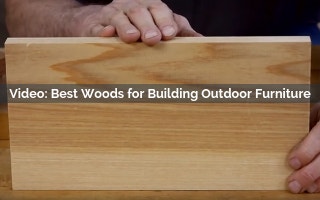Video: Best Woods for Building Outdoor Furniture

What are the best woods to use when building outdoor furniture? Learn which woods are best for outdoor projects. Ultraviolet rays and moisture are tough on wood. Not all wood can stand up to the elements. Learn which woods will last when exposed to prolonged outdoor conditions.
Skill Builder Video
Best Woods for Building Outdoor Furniture - Video Transcript
Chris Marshall: What are the best woods to use for outdoor furniture? The truth is, and you probably already know this, not all woods stand up equally well to the elements or to wood-boring insects like termites and carpenter ants. Mother Nature is hard on woodworking projects. The species you choose impact not only impact how long your outdoor furniture lasts, but how often you have to refinish it or even apply a finish at all. The good news is that there are some excellent species options for outdoor furniture, and I've got five of them that I'd like to show you here.
The first one is white oak. It has a nearly closed grain structure through the end grain and the pores are filled with tylose, a substance that makes the wood nearly watertight through the end grain and naturally resistant to decay. Now, don't confuse white oak with red oak, which is what you're going to find more commonly at a home center. Red oak has an open grain structure on the end grain which wicks up moisture and it doesn't have the same decay resistance as white oak does. So go to a hardwood lumber yard and shop for white oak specifically, it makes a big difference. White oak is also hard, dense and very heavy, so keep that in mind when you're considering the weight of your outdoor furniture.
Here's another good choice, cypress. It's pretty easy to find in southern and eastern states. Cypress is a very soft wood like pine that's easy to cut, shape and fasten. It's also lightweight and holds up like a champ outside especially when it's old growth. Here's a garden bench I built for our magazine about 15 years ago from some reclaimed Louisiana sinker cypress. Now, this wood used to be part of a Civil War era railroad bridge and it has stood out in the elements ever since. Aside from the fact that it's turned a little gray, it's every bit as sturdy as the day I built it.
Here's one you can find commonly at most home centers and lumber yards, western red cedar. Like cypress, cedar is soft and lightweight and I think it smells great when you cut or sand it. It is quite a range of coloration between the light colored sapwood and the darker hardwood. Among these other options, western red cedar is pretty affordable too but it can have a lot of knots, it's splintery and it tends to split at the ends, so be sure to predrill your screw holes.
A fourth-grade species for outdoor furniture is African mahogany, and that's what I've used for this folding Adirondack chair. It's also a favorite of boat builders. Mahogany has a beautiful grain pattern, especially when it's quarter sawn like it is on this chair. Although it's a hardwood, Mahogany has a soft structure that's easy to cut, shape and sand. Here's another benefit of Mahogany, you can find it in wide widths pretty easily. This board, for instance, is 13 inches wide, clear of defects, and it started out at 14 feet long, and from a hardwood supplier, this is not all that uncommon.
Fifth, here's Spanish cedar. It's an exotic lumber but it doesn't cost a fortune. This one smells great. It holds up well outdoors but it's used most commonly for cigar humidors. Spanish cedar has similar working characteristics to Mahogany. It's soft, lightweight and easy to machine and in terms of how they look, the two could be cousins. You might be wondering, what about other common woods like pine or poplar? How well do those hold up outdoors? Well, not as well as these five do by quite a stretch. If you're going to use a common wood for your outdoor furniture make sure it's not in constant contact with the ground or stays wet. Paint it or varnish it with Spar varnish and stay on top of the finishing, otherwise, eventually, it's going to rot.
I think these are much better choices and when you think about it, if you're going to go to the time, effort and expense of building a nice piece of outdoor furniture, why not choose a wood that's going to help it last as long as possible, so some things to think about. I'm Chris Marshall with Woodworkers Journal Magazine and thanks for watching.
Keep the inspiration coming!
Subscribe to our newsletter for more woodworking tips and tricks



